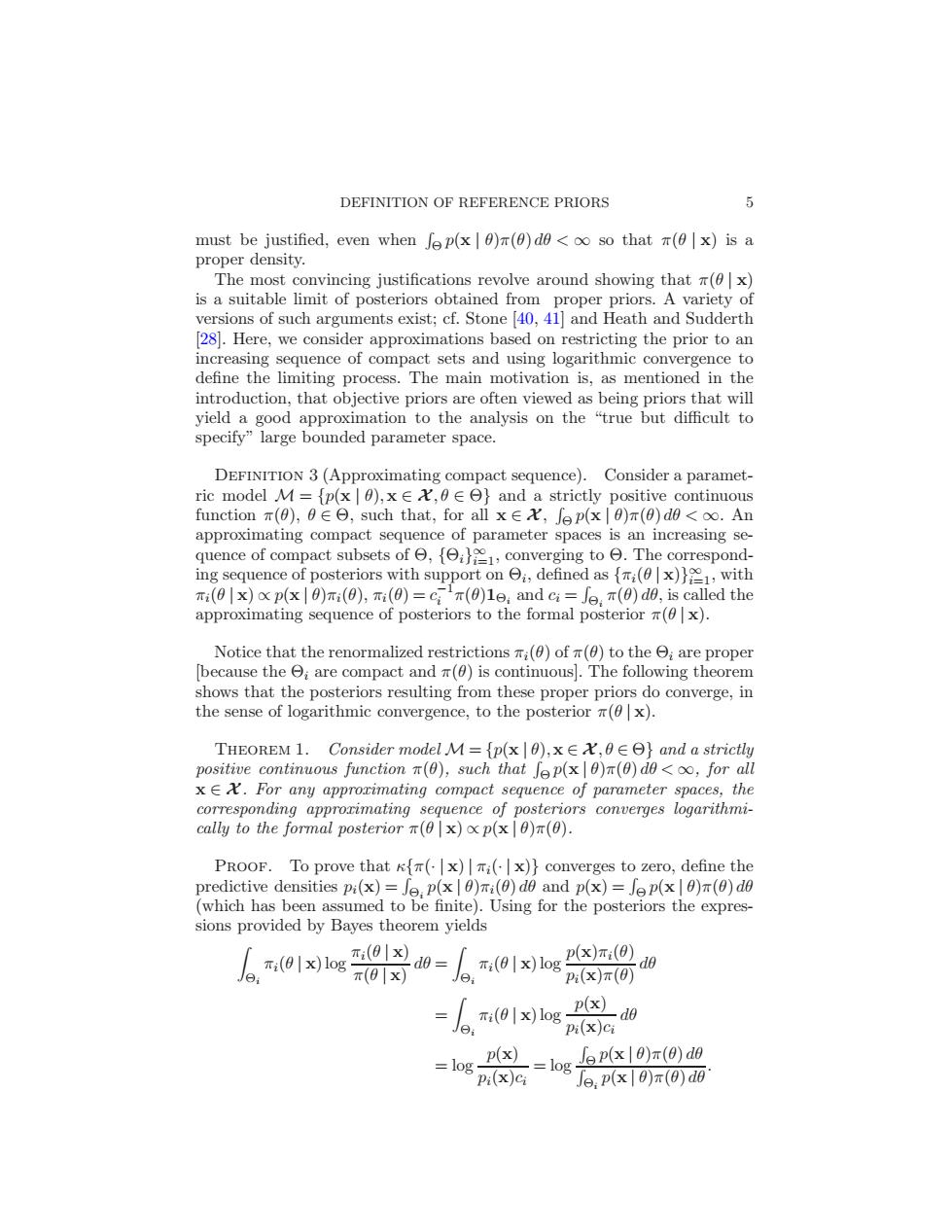正在加载图片...

DEFINITION OF REFERENCE PRIORS 5 must be justified,even when fep(x )()de<oo so that t(x)is a proper density. The most convincing justifications revolve around showing that r(x) is a suitable limit of posteriors obtained from proper priors.A variety of versions of such arguments exist;cf.Stone [40,41]and Heath and Sudderth 28].Here,we consider approximations based on restricting the prior to an increasing sequence of compact sets and using logarithmic convergence to define the limiting process.The main motivation is,as mentioned in the introduction,that objective priors are often viewed as being priors that will yield a good approximation to the analysis on the "true but difficult to specify"large bounded parameter space. DEFINITION 3(Approximating compact sequence).Consider a paramet- ric model M={p(x|f),x∈,0∈O}and a strictly positive continuous functionπ(0),0∈Θ,such that,.for all x∈X,fep(x|0)π(0)d0<o.An approximating compact sequence of parameter spaces is an increasing se- quence of compact subsets ofΘ,{ei}≌1,converging to e.The correspond- ing sequence of posteriors with support on ei,defined as [i(x)1,with Ti(6|x)xp(x|8)π(0),Ti()=cπ(e)le,andc=Jaπ(e)d,is called the approximating sequence of posteriors to the formal posterior r(x). Notice that the renormalized restrictions mi()of (0)to the O;are proper [because the e;are compact and r(0)is continuous].The following theorem shows that the posteriors resulting from these proper priors do converge,in the sense of logarithmic convergence,to the posterior r(x). THEOREM 1.Consider model M={p(x|0),x∈X,0∈Θ}and a strictly positive continuous function n(0),such that fep(x0)(0)de<oo,for all xE X.For any approrimating compact sequence of parameter spaces,the corresponding approrimating sequence of posteriors converges logarithmi- cally to the formal posterior (x)p(x0)n(0) PROOF.To prove that k{(x)|i(x)}converges to zero,define the predictive densities pi(x)=Je,p(x)ni(0)do and p(x)=Jep(x)(0)do (which has been assumed to be finite).Using for the posteriors the expres- sions provided by Bayes theorem yields π(0|x)log le: 01风d0=e p(x)π:(0 _ao π(0|x) π(0|x)1og P(x)π(0 =。(01x)log p(x) d0 i(x)ci =log p(x) pi(x)ci 二log Jep(x0)(0)do Je.p(x0)(0)doDEFINITION OF REFERENCE PRIORS 5 must be justified, even when R Θ p(x | θ)π(θ) dθ < ∞ so that π(θ | x) is a proper density. The most convincing justifications revolve around showing that π(θ | x) is a suitable limit of posteriors obtained from proper priors. A variety of versions of such arguments exist; cf. Stone [40, 41] and Heath and Sudderth [28]. Here, we consider approximations based on restricting the prior to an increasing sequence of compact sets and using logarithmic convergence to define the limiting process. The main motivation is, as mentioned in the introduction, that objective priors are often viewed as being priors that will yield a good approximation to the analysis on the “true but difficult to specify” large bounded parameter space. Definition 3 (Approximating compact sequence). Consider a parametric model M = {p(x | θ),x ∈ X ,θ ∈ Θ} and a strictly positive continuous function π(θ), θ ∈ Θ, such that, for all x ∈ X , R Θ p(x | θ)π(θ) dθ < ∞. An approximating compact sequence of parameter spaces is an increasing sequence of compact subsets of Θ, {Θi}∞ i=1, converging to Θ. The corresponding sequence of posteriors with support on Θi , defined as {πi(θ | x)}∞ i=1, with πi(θ | x) ∝ p(x | θ)πi(θ), πi(θ) = c −1 i π(θ)1Θi and ci = R Θi π(θ) dθ, is called the approximating sequence of posteriors to the formal posterior π(θ | x). Notice that the renormalized restrictions πi(θ) of π(θ) to the Θi are proper [because the Θi are compact and π(θ) is continuous]. The following theorem shows that the posteriors resulting from these proper priors do converge, in the sense of logarithmic convergence, to the posterior π(θ | x). Theorem 1. Consider model M = {p(x | θ),x ∈ X ,θ ∈ Θ} and a strictly positive continuous function π(θ), such that R Θ p(x | θ)π(θ) dθ < ∞, for all x ∈ X . For any approximating compact sequence of parameter spaces, the corresponding approximating sequence of posteriors converges logarithmically to the formal posterior π(θ | x) ∝ p(x | θ)π(θ). Proof. To prove that κ{π(· | x) | πi(· | x)} converges to zero, define the predictive densities pi(x) = R Θi p(x | θ)πi(θ) dθ and p(x) = R Θ p(x | θ)π(θ) dθ (which has been assumed to be finite). Using for the posteriors the expressions provided by Bayes theorem yields Z Θi πi(θ | x) log πi(θ | x) π(θ | x) dθ = Z Θi πi(θ | x) log p(x)πi(θ) pi(x)π(θ) dθ = Z Θi πi(θ | x) log p(x) pi(x)ci dθ = log p(x) pi(x)ci = log R Θ p(x | θ)π(θ) dθ R Θi p(x | θ)π(θ) dθ